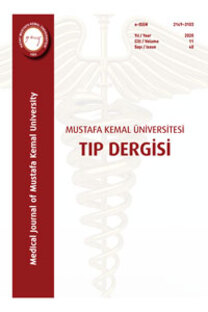FOLİKÜLER AMELOBLASTOMA: OLGU SUNUMU
Giriş: Ameloblastoma lokal invazyon yapan,yavaş büyüyen odontojenik epitel orjinlibenign bir tümördür. Sıklıkla mandibula olmaküzere çene kemiklerine yerleşirler. FollikülerAmeloblastoma konvansiyonelameloblastomların bir subtipidir. Biz demandibulada destrüksiyona neden olmuş birolgumuzu sunmak istedik.Olgu: Kırkdokuz yaşında bir erkek hasta ağıziçinde şişlik şikayetiyle Mustafa KemalÜniversitesi (MKÜ) Diş Hekimliği FakültesiPolikliniğine başvurmuştur. Panoramikincelemede mandibulada multilobüle tümörallezyon izlenmesi üzerine, yapılan bilgisayarlıtomografi görüntülemesinde sol mandibularamus angulus düzeyinde 5.5x4.5 cmboyutlarında yer yer kistik alanlar içerenekspansiyon ve destrüksiyon yapmış kitlelezyonu tespit edilmiştir. Lezyondan alınaninsizyonel biopsinin MKÜ Tıp FakültesiPatoloji laboratuarında ameloblastoma ileuyumlu raporlanması üzerine MKÜ TıpFakültesi Hastanesi KBB ekibi tarafındanhastanın radikal eksizyonu gerçekleştirilmiştir.Materyalin incelenmesinde olgununameloblastoma folliküler varyant tanısıonaylanarak hastanın lokalrekürrens ihtimalinedeniyle takibi önerilmiştir.Sonuç: Ameloblastomalar odontojenik epitelorjinli en sık rastlanılan gerçek neoplazmlardır.Ameloblastomalarda tedavi lezyonunnatüründen çok yayılımına ve çevre yapılarlailişkisine bağlıdır.
Anahtar Kelimeler:
Ameloblastoma, mandibula, odontojenik
Follicular Ameloblastoma: Case Report
Introduction: Ameloblastoma is a benignepithelial odontogenic tumor which is locallyinvasive and of slow growth. Ameloblastomaslocates on jaw bones preferably mandibula.Follicular ameloblastoma is a subtype ofconventional ameloblastomas. We present ourcase that has caused wide destruction inmandibula.Case: A-49-year old male patient referred toMustafa Kemal University DentistryDepartment with intra-oral sweeling. Onpanoramic view, a multilobular tumoral lesionhas been determined and computedtomography scan revealed 5.5x4.5 cm sizedmass lesion with cystic areas that hasdestructed and expanded left mandibula ramusangulus. Theincisional biopsy has beenreported as ameloblastoma by MKU PathologyLaboratory and the patient was sent toOtorhinology Department for radical surgery.The final diagnosis has been confirmed asfollicular ameloblastoma after the examinationof the material and follow-up of the patient hasbeen advised for local recurrence.Conclusion: Ameloblastomas are the mostfrequent neoplasms of realodontogenicepithelium. The prognosis of thetreatment is basically dependent to theextension of the lesion and adjacent structuresinvolvement rather than origin of lesion
Keywords:
Ameloblastome, mandibula, odontogenic,
___
- Ledesma-Montes C, Mosqueda-Taylor A, Carlos-Bregni R, León ER, Palma-Guzmán JM,
- Paéz-Valencia C, Meneses-García A. Ameloblastomas: a regional Latin-America multicentric
- study. Oral Diseases.2007;13.303–7.
- Sun ZJ, Wu YR, Cheng N, Zwahlen RA, Zhao YF. Desmoplastic ameloblastoma - A
- review. Oral Oncology. 2009;45.752–9.
- Hertog D, van der Waal I. Ameloblastoma of the jaws: A critical reappraisal based on a 40-
- years single institution experience. Oral Oncology. 2010;46.61–4.
- Thompson L. World Health Organization classification of tumours: pathology and genetics
- of head and neck tumours. Ear Nose Throat J. 2006;85:74.
- Jun Li T,Tang Wu Y,Feng Yu S,Yan Yu G. Unicystic ameloblastoma. American Journal of
- Surgical Pathology. 2000;24:1385-92.
- Robinson L,Martinez M. Unicystic Ameloblastoma: A prognostically distinct entity.
- Cancer 1977;40.2278-85.
- Curi M M, Dib L L, Pinto DS. Management of solid ameloblastoma of the jaws with liquid
- nitrogenspray cryosurgery. Oral Surgery Oral Medicine, Oral Pathology, Oral Radiology and
- Endodontics. 1997;84.339-44.
- Jones S P,Ghali G E,Lowe B.Eichstaedt M. Large maxillary mass in a child. Journal of
- Oral and Maxillofacial Surgery. 2001;59.1057-61.
- Lau S K, Tideman H,Wu PsC. Ameloblastic carcinoma of the jaws. Oral Surgery Oral
- Medicine, Oral Pathology, Oral Radiology and Endodontics. 1998;85.78-81.
- Ameloblastoma: biological profile of 3677 cases. Reichart PA, Philipsen HP, Sonner S.
- Europian Journal of Cancer Biology and Oral Oncology. 1995;31.86-99.
- ISSN: 2149-3103
- Yayın Aralığı: Yılda 3 Sayı
- Başlangıç: 2010
- Yayıncı: Hatay Mustafa Kemal Üniversitesi Tıp Fakültesi Dekanlığı
Sayıdaki Diğer Makaleler
Taner Hafızoğlu, İbrahim Şilfeler, İbrahim Tanıdır, Şahin Hamilcikan, Fugen Pekun, Asiye Nuhoğlu
ANKİLOZAN SPONDİLİTTE GÜNCEL TEDAVİ SEÇENEĞİ: TÜMÖR NEKROZ FAKTÖR ALFA ANTAGONİSTLERİ
FOLİKÜLER AMELOBLASTOMA: OLGU SUNUMU
Tümay Özgür, Mehmet Akın, Hasan Gökçe, Ercan Akbay, İbrahim Damlar
